
We are currently living in an era of digital cloud technologies. The modern world progresses, and technology grows more advanced with every passing moment. Every aspect of the world we currently live in has technology integrated one way or the other. The world continues to create space for more advanced emerging technologies that promise an even more efficient future.
However, we have now reached the pinnacle where we require resources to store the massive amounts of data we generate. And the answer to that is cloud technologies. The newest technology trends have all implemented cloud computing technology and servers to boost their efficiency in performing tasks.
Cloud technology is booming, and for all the right reasons, it had exponential growth last year, and the predictions are that it will surpass its own records. According to the global cloud computing market forecast, cloud initiatives will take up 70% of all tech by the time we wrap up 2020.
Therefore, considering these facts and stats, there is no doubt that cloud technology is here to stay.
There are many cloud-based technologies are emerging since last decade. tech-giants such as Google Cloud, Amazon AWS, Microsoft Azure are the most prominents stakeholders in this sector.The following are the top ten emerging cloud technologies and trends that we will see throughout 2020.
Blockchain might have been the back-end for cryptocurrency. However, over the years, people have identified it as much more than just a transparent ledger system to process a virtual currency system.
As technology makes its way to other sectors, cloud technologies has been one of the quickest formats to integrate it. Because cloud technologies at its core is an environment dedicated to storing multitudes of data, blockchain works as the decentralized version of that core concept.
It can become a strong facilitator of decentralized cloud solutions, which can provide distributed strong computing support to overcome data management issues.
The hosting sector was roving around shared and dedicated server models so far. But, the advent of serverless technology overturned the story more into a cloud-based picture. Serverless computing, also known as ‘function as a service,’ is one of the highly efficient branch of cloud computing technologies. The execution model takes the cloud provider to run the server and changes the dynamic management for allocating machine resources. It allows the cloud-tech to work faster and more efficiently.
Before Serverless computing, cloud customers had guessed the level of resources they would pay for. Now thanks to Serverless, pricing is based on the actual amount of resources consumed by the application rather than for the purchased units per capacity.
Artificial intelligence and machine learning are another giant leaps into the merging technology spaces. They might take up the entirety of what we know as technology today and shape the future. AI has dwarfed all other technological advancements for the right reasons because a promising technological stance that rids us of human assistance just speaks volumes.
It might exist as a separate entity to the cloud. But cloud providers have AI, and machine learning tools that will be able to provide cloud-based solutions for the next generation of visionaries as the technology matures over the years.
In this cloud era, if I may say so, everything can be connected to the internet. Where your wristwatches are smart-watches, and Samsung refrigerators can tweet, there is no stopping on this one. This vast network that connects all your devices is IoT and the lead generator of loads of data.
You might think IoT is separate from the cloud. But to think about it, the intricate connection of creating and storing data is all that it takes.
Both AR and VR have proven that they are valuable addition when it comes to the field of digital entertainment and information-based technology. However, solutions undertaking these technologies have faced the need for processing platforms that affected the cost to benefit the equation. The industry-wide adoption of cloud technology has emerged as a savior for AR and VR.
It reinforced the pay-as-you-go model that allowed access to the previously unattainable levels of immersive experiences through AR and VR. High throughput networks and the low latency levels have given instant access to remote data and a highly centralized system.
Docker made containers more accessible and easy to use technology. It is basically a set of platforms that work as service products that use OS-level virtualization to deliver software in a packaged format called containers.
Because containers are separate from one another and carry the bundle of their own software, libraries, and configuration files, they make communication through defined channels.
As the technology is easily and rapidly being adopted, next-generation virtual machines will help power a multi-cloud computing dimension. Kubernetes, a container management system by Google, will soon be seen as having stricter, multitenant, application isolation at the hardware level.
According to Gartner, the average cost of IT downtime has been calculated close to $5600 per minute. Of course, much of the cost is accounted for depending on the business field the organization is in.
For instance, if you are an e-commerce firm providing cheap essay writing service, the cost will be turmoil as the downtime will be the accumulation of all the missed sales opportunities.
As the organizations move towards taking the digital route of operations, they need to be legally compliant and confident in their disaster recovery strategies and formulate them through automated means to cut down the recovery time.
Microservices might have gained hype back in 2012, but their much-awaited return has caused more buzz since they are more efficient for cloud computing. Updating large and complex software can become slow and inefficient if not for Microservices.
Microservice architecture is a variation of a service-oriented architectural structure that arranges an application in the way of making it a collection of loosely coupled services.
These services are so fine-tuned, and the protocol so lightweight that it breaks these rigid apps into smaller joined modules of services. This modular approach allows the service teams to independently update these modules without taking in the whole app.
Similar to microservices, DevOps also started gaining momentum around 2012. Back in those days, it was like a cultural shift from what people knew of technology. Today, DevOps is seen as a way to speed up software and provide continuous delivery and integration besides shortening the life cycle of system development.
It works wonders for both developers and operations managers because it is an adaptable set of practices that combines software development with IT operations. The combination with cloud technology is to create the ultimate agile software with continuous delivery, high software quality, and storage to gain competitive advantage.
The digital age has led business operations to be conducted at a rapid speed. Because believe it or not, our data consumption needs have become instantaneous. Customers can not sit idle and wait for processes, and enterprises have become the target to meet the demands.
IT systems are required that deliver services at a pace far more increased than traditional systems. This has increased the need for hyper-scaling. It refers to the capability of an IT system to scale rapidly to respond and meet the consistently heavy loads of demand. Basically, a cloud reform for data centers to give organization extreme flexibility.
It can be said that cloud technology will undoubtedly become the leading advancement of the ongoing digital era. It will transform the digital realm as we know it soon. So keep an eye out for the trends as 2020 continue to unravel.

